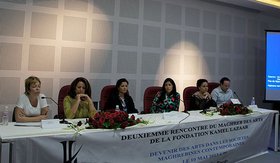News
Art and its Prospects in Contemporary Maghrebi Societies
The second meeting of Maghreb des Arts
The Kamel Lazaar Foundation convened the second forum of Maghreb des Arts on May 10th at the Bardo Museum in Tunis. The theme in question was the future of the arts in the contemporary Maghreb. The forum followed up on questions posed last year about coordination issues, archiving, and theoretical research in Maghrebi visual arts. The forum was organized by Rachida Triki, who invited key players and theoreticians from the Maghrebi art scene to participate in the debate.
A number of specialists, art historians, archeologists, critics and artists gathered to listen and discuss ideas with the participating panellists of the four boards on:
1. 'Sponsorships in the Maghreb', with panellists Oussama Rifahi, Ghita Triki and Wafa Gabsi.
2. 'The Structure of the Museum and Sponsorships', with panellistsAbdelkader Damani, Bernadette Nadia Dufrêne, Farid Zahi.
3. 'The Art Market. Case study: Tunisia', with panellists Lilia Ben Salah, Selma Feriani, Aicha Gorgi, Essia Hamdi, Hamadi Cherif, Bchira Triki Bouazizi, Sana Tamzini.
4. 'How to Reactivate Traditional Art in a Contemporary Manner', with panellists Nacera Benseddik, Houcine Tlili, Mehdi Benedetto.

The four panel discussions were packed with information, suggestions and debate. The President of the Foundation, Kamel Lazaar, inaugurated the forum with a speech highlighting the exciting boom that the Tunisian art world is currently experiencing. He was optimistic about the increasing creativity in all areas of the arts, including visual arts, cinema, theatre and music. According to Lazaar, there has historically been – and there continues to be – a variety of common ground between the different countries of the Maghreb with regards to art and culture. He encouraged efforts to enable cultural practitioners to work with greater ease and in better conditions, such as projects offering financial aid for art production and for the creation of spaces for constructive criticism and research.
Ghita Triki of the Actua Foundation at the Attijariwafa Bank spoke during the first panel on sponsorships. Triki is the head of the pôle art et culture ('the art and culture hub'), which houses a large number of contemporary artworks. In her presentation, she listed the activities she is involved in. These range from purchasing and conserving contemporary works of art, to organizing permanent and temporary exhibitions, to funding young artists' projects. The foundation already has 286 projects to its name, and has established and nurtured partnerships with a variety of different institutions. Triki also explained how this system of sponsorship for projects has made an important impact on society by promoting cultural production.
Oussama Rifahi, Executive Director of the Fund for Arab Arts and Culture (AFAC), built on this idea of social impact, emphasizing the importance of defining the role of contemporary art sponsorship for contemporary art production. He went on to compare the main approaches to art sponsorship globally, from the USA, which does not have a Ministry of Culture, to the European model, where institutions rely on government backing. He concluded that the Arab world and the Maghreb are influenced by both models, and indicated that this could have a positive impact on art and cultural production in the region by bringing together the emerging art market and institutional sponsorship. Rifahi discussed the different projects that AFAC has launched to encourage artistic and cultural production within a social network. Wafa Gabsi, a Tunisian art critic, emphasized the importance of artists and curators' residencies in the improvement of the local production of contemporary art.
The second session focused on the structures of museums and their impact on the art world. Bernadette Dufrene, a specialist in museum structures and cultural communication, spoke about the Centre Pompidou in Paris. The author of Centre Pompidou, 30 ans d'histoire (The Pompidou Centre, a thirty-year history) (2007) explained how the museum has evolved to offer a virtual experience to a wider public. Abdelkader Dahmani, director of the platform VEDUTA at the Lyon Biennale of Contemporary Art, took the concept further by imagining a museum that could expand to the size of a city. He explained how he had managed to engage the whole city of Lyon through interactive art, encouraging its citizens to become cultural operators by taking activities outside of the traditional boundary of the museum walls. It was Dahmani's opinion that the traditional concept of the museum ought to be abolished to make way for more creative methods of bringing art into society. He also commented that Tunisia should not wait for a national museum to encourage the growth of its cultural sector.
This all prompted a great deal of criticism from the audience; in particular from artists, who insisted that the country needs official structures such as modern and contemporary art museums to legitimize their work, and to make it accessible to a wider audience. In light of this, the issue of the 12,000 works of art that have been bought by the state and hidden from public view was raised. Farid Zahi, a Moroccan art critic, made a comparison with the problematic structure of museums in Morocco. He criticized the lack of transparency of museums in Casablanca, and the dearth of art books and magazines, which he sees as necessary for the cultural development of a society.
